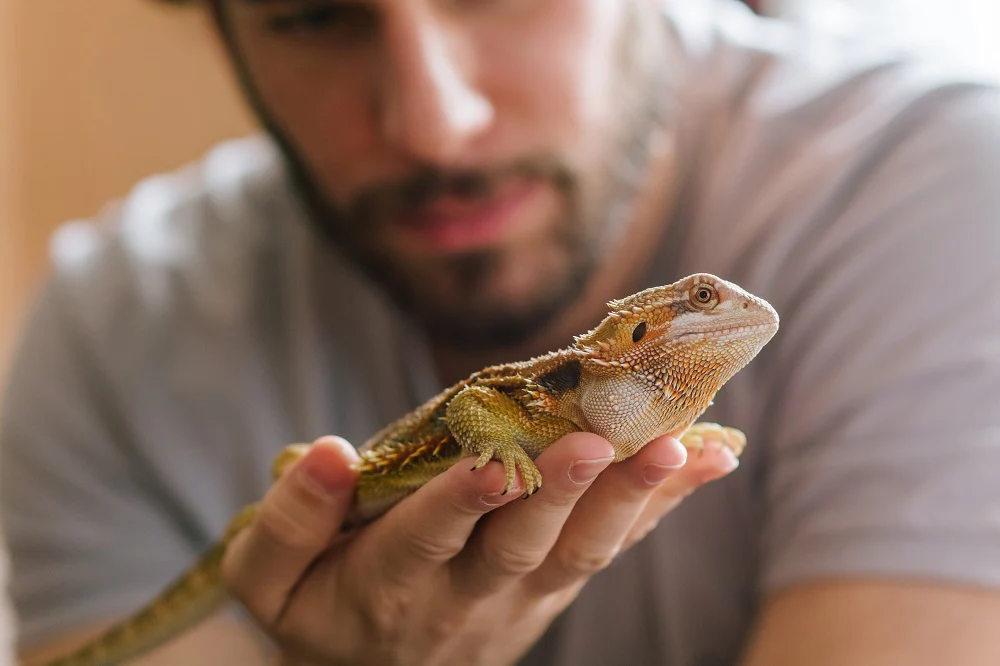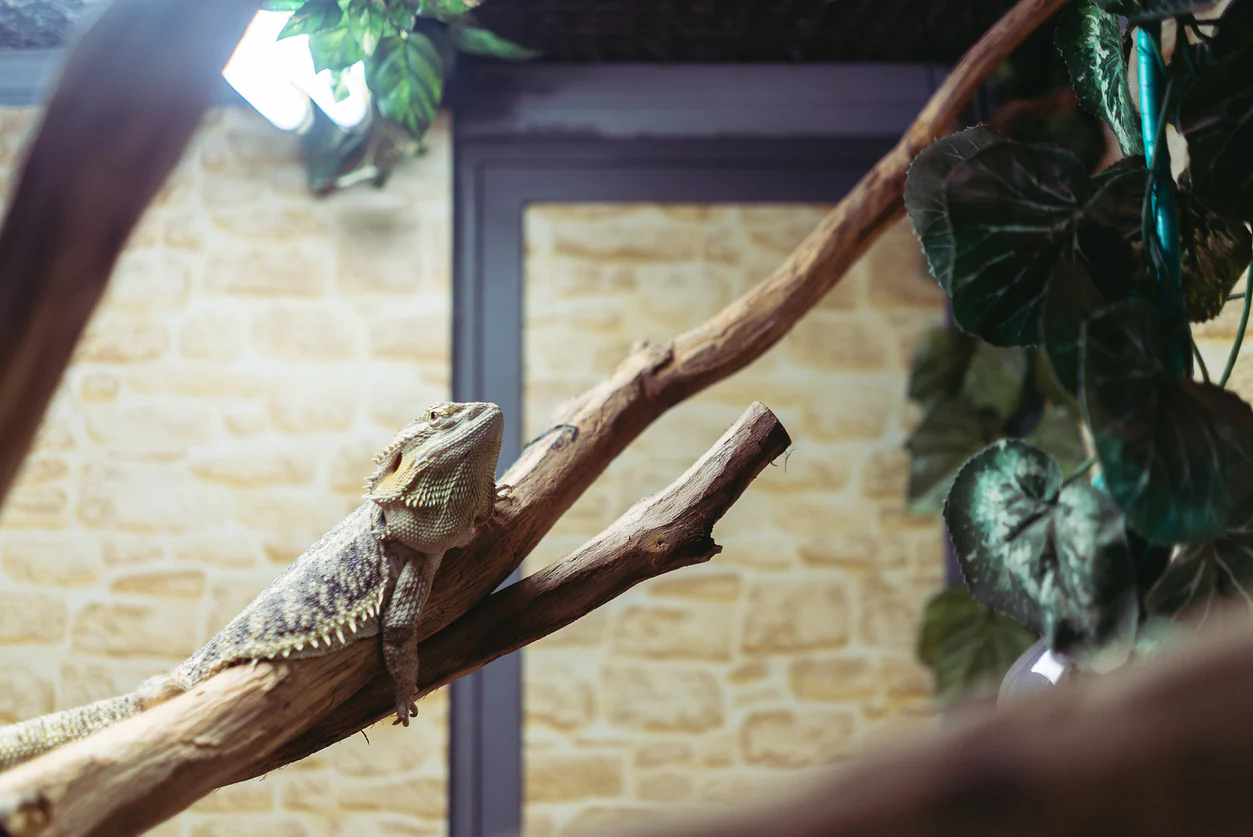There are a TON of reptile care myths out there. Some are downright harmful, while others are sneakier — simply outdated information that has had enough time to circulate around the hobby to become common practice. In order to improve the standards of care in the reptile hobby and create better educated, more capable reptile owners, we first need to understand the myths that threaten to undermine progress.
In our last article on this topic, we outlined 15 common reptile care myths. But there’s just so many myths floating around in the reptile hobby that we knew it would need a sequel. So here are 14 more myths about caring for reptiles, and why they’re wrong:
MYTH #16: Feeding a snake more often is the best way to make it grow bigger, faster
This is a practice called “power feeding,” and it is very dangerous to a snake’s health. Will it grow bigger and faster? Most likely, yes. However, rapid growth like this is very strenuous on snake bodies and is known to harm organ function, contribute to severe obesity, and decrease lifespan.
MYTH #17: Reptiles that eat other animals can live on a vegan/vegetarian diet
Vegan and vegetarian alternative protein sources are not enough to replace the nutrients provided by whole prey. Why? For several reasons:
- The reptile is very unlikely to be interested in eating alternative foods.
- Whole prey items such as feeder rodents contain a wide spectrum of nutrients that can’t be accurately replicated with a vegetarian (and particularly vegan) approach to nutrition.
- Carnivorous reptiles may not be able to properly digest plant protein.
Vegetarian and vegan diets work for humans because we are omnivores — and VERY successful omnivores, at that. We’re practically walking garbage disposals. That’s not the case for reptiles, particularly obligate carnivores like snakes. And forcing them to eat a vegetarian or vegan diet will likely result in severe nutrient deficiency, starvation, and eventually death.
MYTH #18: All reptile supplements are more or less the same
The good news is that reptile supplements are not quite as diverse as heat bulbs. The bad news is that you still can’t walk into a pet store and grab the first reptile supplement that catches your eye. Each supplement is made from different ingredients, contains different levels of vitamins and minerals, vary in quality, and may even be developed for different purposes.
There are three primary types of reptile supplements:
Calcium supplements. These supplements are usually pure calcium carbonate powder, and may or may not have vitamin D3 and/or additional minerals mixed in. Read the ingredients label and pay attention to the source of the calcium, how much vitamin D3 it contains, and whether phosphorus is present.
Multivitamin supplements. These supplements are a powder blend of a variety of vitamins essential to reptile health, such as vitamins A, B, C, D3, K, beta carotene, iodine, choline, etc. They may also contain other ingredients like bee pollen. Read the ingredients label and pay attention to how much vitamin D3 it contains and whether phosphorus is present.
Hybrid supplements. These supplements are a combination of calcium and multivitamin in a dose that can be administered at every feeding with a low risk of over-supplementation and resulting toxicity.
Some brands of reptile supplements are better than others — Repashy, Arcadia, and Sticky Tongue Farms are known top performers. Generally speaking, use the supplement as directed by the label, but supplementation needs can vary depending on the type of reptile, such as with chameleons and snakes.
MYTH #19: Reptiles are inherently calcium deficient and need as much calcium stuffed into their bodies as possible
This reptile care myth got its start from the extreme emphasis placed on calcium supplementation for reptiles. Because new keepers are told to use calcium powder without being educated on how it works or why it’s important, they often gain the mistaken impression that reptiles are somehow inherently calcium deficient. This is not the case. Their captive diet, however, can be. So instead of stuffing your reptile with calcium, use the supplement strategically. Normal reptiles will get all the calcium they need from normal dusting on feeder insects, or, if herbivorous, a light dusting on salads.
Feeder insects should not be caked in calcium, either. Some of the original color of the insect should still be visible after dusting. If the insects look like powdered donuts after dusting, you used too much.
MYTH #20: Terrestrial reptiles can’t climb
Myths about caring for reptiles often stem from misunderstandings, and this is definitely one of them. Terrestrial reptiles may not be able to climb to the canopy of the rainforest, but they can climb over basic obstacles in their path (ex: rocks, fallen logs, etc.). Many are also known to actually be quite enthusiastic climbers, and regularly climb small trees and shrubs in search or prey or to get a better vantage of their territory. In other words, they’re much more capable of climbing than we give them credit for, and being able to do basic climbing does not make a reptile arboreal.
Providing appropriate climbing objects such as thick branches, cork logs, rocks, and other decor in a reptile’s enclosure can help vary the terrain, strengthens their muscles, improves their general fitness, and better utilizes the space offered by the enclosure.
Reptiles that seem to be clumsy climbers or seem to fall often are likely to be out of shape from being kept in an environment without climbing objects, or they may have a neurological disorder as the result of irresponsible breeding practices.
MYTH #21: Reptiles are cheap pets
Due to their special husbandry needs, reptiles can actually be quite expensive pets. You can do things to reduce the cost, such as building your own enclosure, mixing your own substrate, and foraging/making your own décor, but there are some things that absolutely can’t be skimped on, like high-quality UVB lighting. At the end of the day, the fact still stands: reptiles are expensive pets.
This also means that reptiles make terrible gifts for children.
MYTH #22: Desert reptiles shouldn’t have water bowls because it will make the enclosure too humid
Adding a water bowl to a reptile enclosure only makes it negligibly more humid, especially if said enclosure is well-ventilated. Furthermore, although there are some species of desert reptile that will instinctively binge on water if it is regularly available, these are few and far between. This reptile care myth is especially pervasive in the bearded dragon community, where it does a lot of harm. Generally speaking, it is cruel to deny a reptile ready access to water, and refusing to provide a water bowl in their enclosure will likely contribute to severe dehydration and associated health problems.
MYTH #23: Desert reptile enclosures should be as dry as possible
Although we often picture deserts as barren places devoid of life or moisture, this is not the case. Your desert-dwelling reptile is living proof that there is moisture in this environment, as where there is water, there is life. Water in the desert often takes the form of underground moisture and plants, but it’s also present in the air. The Sahara Desert, one of the driest places on Earth, still has an average relative humidity of about 25%.
Now consider this: most desert-dwelling reptiles that are in the pet trade aren’t from the Sahara Desert. Bearded dragons are from Central Australia, where relative humidity fluctuates between 10-65% on a daily basis. Leopard geckos are from the Middle East/Eastern Asia, where they have a very broad range of habitat from arid semi-desert and grassland areas to dry forests, and are known to tolerate average relative humidity levels of up to 65% or so.
As with providing heat and UVB, when it comes to humidity, you need to provide a range of humidity levels within a desert reptile’s enclosure. One of the best ways to do this is by using a naturalistic, dry substrate, good ventilation, and a halogen heat lamp. Humidity levels under a heat lamp can get as low as 10%, thus helping create a healthy humidity gradient. As long as your desert reptile has access to areas of very low humidity and has appropriate basking temperatures and UVB, it is unlikely to get a respiratory infection.
MYTH #24: Some reptiles should be soaked or bathed regularly
Unless the reptile in question is amphibious — in which case it should always have access to an appropriate amount of water in its enclosure — there is no need to bathe or soak it regularly. This does not significantly improve hydration if the reptile already has access to drinking water in their enclosure, and this reptile care myth (specifically as applies to bearded dragons) has been disproved multiple times by veterinarians. Furthermore, if the only way you can get your reptile to shed properly is via bathing, then that means that humidity in your enclosure is too low and needs to be fixed.
There are a few occasions when it may be appropriate to bathe or soak a reptile:
- As a last-resort tactic for removing stuck shed, particularly with rescues
- The reptile crawled through its own poo and needs to be decontaminated
- The reptile is an educational animal and needs to be cleaned prior to a demonstration
- The reptile is not stressed by water and the keeper wants to provide an opportunity for exercise and enrichment
MYTH #25: Pet store employees are reliable sources of information on reptile care
Pet store employees are generally minimum-wage employees who applied for the job because they like animals (usually dogs and cats). They typically undergo minimal training on the animals sold by the store, and at the end of the day know little to nothing about the reptiles in stock except for which products to recommend (which usually aren’t the best).
There are exceptions to this rule, but to most of them, it’s just a job. Expecting a pet store employee to be reptile experts is like expecting the employees in a grocery store to be nutritionists.
MYTH #26: Keeping pet reptiles will give you salmonella
Thanks to a salmonella scare in the 90s attributed to the sudden popularity of pet turtles, pet reptiles in general are now strongly associated with salmonellosis. However, they don’t deserve this reputation. Aquatic turtles are particularly potent potential vectors of salmonella due to the fact that they swim in their own toilet, and most of the cases in the 90s were due to poor post-handling hygiene and the fact that children were kissing (and in some cases even ingesting) the baby turtles.
Here’s the facts: Only 5 of every 200 salmonella cases are attributed to reptiles. The rest of the cases come from far more common household vectors, such as meat, poultry, eggs, milk, vegetables, and even other pets. Considering that there are about 328 million people currently living in the US and only about 2-4 million cases of salmonella per year, your chances of getting it even from those sources is still pretty slim.
Getting salmonella from a pet reptile is almost always due to poor hygiene practices. With good hygiene, it’s likely you’ll never have a problem with it. Here are some best practices:
- Wash your hands often and for at least 20 seconds. (This should already be a habit, thanks to COVID-19.)
- When you can’t wash your hands after handling, use hand sanitizer.
- Don’t kiss your reptile.
- Don’t take reptiles out for handling while eating.
- Clean up reptile poo as soon as it appears.
- Deep-clean and disinfect your reptile’s enclosure regularly, about once every 3-6 months (unless bioactive).
- If you let your reptile free-roam at all, get your floors and upholstery cleaned with hot water or steam at least once a year.
- Be especially careful with pet turtles.
MYTH #27: Chubby reptiles are cute and healthy
It is well known that when humans have too much body fat, excess strain is placed on the body’s systems and overall health becomes compromised. Reptiles and mammals are different in many ways, but excessive body fat is a bad thing for all animals. Yet for some reason, many people strive to have chubby reptiles, calling them “cute,” and insisting that fatness is an indicator of health in an animal that actually evolved to thrive in a state of relative deprivation.
The best way to determine whether your pet reptile has a healthy body condition is to look at photos of its wild relatives. Wild reptiles tend to be on the side of very lean, so it’s okay for your reptile to be slightly fatter and less bony. It should not have any glaringly obvious fat accumulation. Providing a balanced diet in appropriate portions and frequency plus a sufficiently large enclosure with plenty of exercise opportunities is key to helping your pet reptile maintain a healthy body condition.
MYTH #28: If a product at the pet store has a picture of your reptile on it, then it’s good to use for that reptile
This reptile care myth is actually sometimes true. That being said, it doesn’t mean you can always trust the picture. It’s just a marketing gimmick designed to get your attention. And even if the product in question can technically be used for that reptile, it doesn’t mean it’s what you should use. Do your own research on the best and most trustworthy products to use for your pet reptile rather than falling for misleading marketing.
MYTH #29: If a reptile is eating regularly, breeding, and doesn’t have any obvious health problems, that means it’s thriving
Last but not least, let’s tackle one of the most stubborn reptile care myths in the industry.
According to the Oxford Dictionary, the definition of “thrive” is “to grow or develop vigorously, to flourish, to prosper, to be successful”.
The definition of “survive” is to “continue to live or exist”.
Eating regularly and breeding are the bare minimums of survival for an animal. These strong instincts help ensure that the animal will live long enough to reproduce and perpetuate its species. Reptiles are also masters of disguising when they’re not feeling well — because in the wild, a visibly sick animal is quick to be picked off by predators. So when a reptile stops eating, won’t breed, or is visibly ill, that doesn’t mean that it’s no longer thriving — it means that the reptile’s life is in danger.
For reptiles to go beyond surviving and begin thriving, they must enjoy optimum health and welfare. What constitutes “optimum” health and welfare is still being explored, but David Mellor’s 5 Provisions of Animal Welfare are a good start. These assume that replicating the positive factors within an animal’s natural habitat are key to helping it thrive in captivity, because animals evolve to take full advantage of all available resources in their habitat.
Whether you’re new to the game or you’ve been keeping reptiles for years, sometimes it can be hard to tell the difference between factual information about reptile care and information that is based on myth. Whenever you come across new information, evaluate its quality with these questions:
- Am I getting this information from an expert or just some random person on the Internet?
- Is this information scientifically-backed?
- Is this information consistent with the nature of the reptile’s wild habitat and ecological niche?
- Would this action improve or decrease a reptile’s captive welfare?
Most of the time, reptile care myths do not improve reptile welfare, and they definitely don’t hold up under the lens of science.




1 comment
erin
thank you for sharing all these
Leave a comment
All comments are moderated before being published.
This site is protected by hCaptcha and the hCaptcha Privacy Policy and Terms of Service apply.